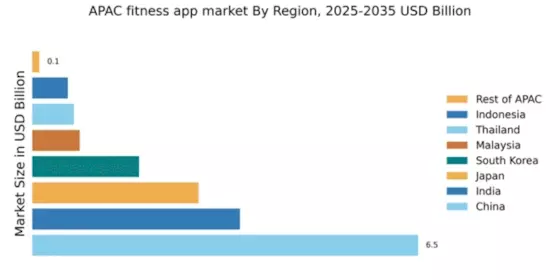China : Rapid Growth and Innovation Drive Success
Key markets include major cities like Beijing, Shanghai, and Guangzhou, where competition is fierce among local and international players. Major brands like MyFitnessPal, Strava, and local apps such as Keep are vying for market share. The business environment is dynamic, with a growing trend towards integrating fitness apps with wearables. The local market is characterized by a strong emphasis on social features and community engagement, appealing to younger demographics.
India : Youth Engagement Fuels Fitness App Growth
Key urban centers like Mumbai, Delhi, and Bangalore are pivotal markets for fitness apps. The competitive landscape features both global players like Fitbit and local startups like HealthifyMe. The business environment is evolving, with a growing emphasis on personalized fitness plans and nutrition tracking. Local dynamics include a strong preference for regional languages in app interfaces, catering to diverse user bases across the country.
Japan : Integration of Fitness and Technology
Tokyo and Osaka are key markets, showcasing a competitive landscape with established players like Fitbit and local apps such as Runkeeper. The business environment is characterized by high consumer expectations for quality and functionality. Local market dynamics include a focus on gamification and community features, appealing to users seeking motivation and social interaction. The integration of fitness apps with healthcare services is also gaining traction.
South Korea : Health Trends Shape Market Dynamics
Seoul is the primary market, with a competitive landscape featuring major players like Samsung Health and global brands like Nike. The business environment is vibrant, with a focus on innovation and user engagement. Local dynamics include a preference for apps that incorporate social features and community challenges, appealing to the tech-savvy population. The integration of fitness apps with smart devices is also a growing trend.
Malaysia : Diverse Market with Unique Needs
Key markets include Kuala Lumpur and Penang, where competition is emerging among local and international players. Brands like MyFitnessPal and local apps are gaining traction. The business environment is evolving, with a focus on affordability and accessibility. Local market dynamics include a strong preference for apps that cater to diverse cultural backgrounds and languages, enhancing user engagement and satisfaction.
Thailand : Health Consciousness on the Rise
Bangkok is a key market, with a competitive landscape featuring both local and international players. Major brands like Fitbit and local apps are competing for market share. The business environment is dynamic, with a focus on community engagement and social features. Local dynamics include a preference for apps that offer group challenges and social sharing, appealing to the younger demographic seeking motivation and support.
Indonesia : Youthful Demographics Drive Growth
Jakarta and Surabaya are key markets, showcasing a competitive landscape with both local and international players. Brands like MyFitnessPal and local startups are gaining traction. The business environment is evolving, with a focus on personalized fitness plans and community engagement. Local market dynamics include a strong preference for apps that cater to diverse cultural backgrounds, enhancing user experience and satisfaction.
Rest of APAC : Varied Preferences Across Sub-Regions
Key markets include emerging economies with varying levels of fitness app adoption. The competitive landscape features a mix of local and international players, with brands like Google Fit and Apple Health making inroads. The business environment is diverse, with a focus on affordability and accessibility. Local dynamics include a strong preference for apps that cater to specific cultural and regional needs, enhancing user engagement and satisfaction.



















Leave a Comment